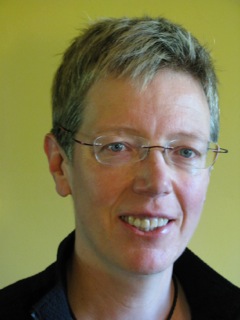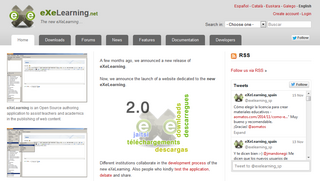Related Research Articles
A learning object is "a collection of content items, practice items, and assessment items that are combined based on a single learning objective". The term is credited to Wayne Hodgins, and dates from a working group in 1994 bearing the name. The concept encompassed by 'Learning Objects' is known by numerous other terms, including: content objects, chunks, educational objects, information objects, intelligent objects, knowledge bits, knowledge objects, learning components, media objects, reusable curriculum components, nuggets, reusable information objects, reusable learning objects, testable reusable units of cognition, training components, and units of learning.
An e-GIF, or eGovernment Interoperability Framework, is a scheme for ensuring the inter-operation of computer-based systems. It is intended to resolve and prevent problems arising from incompatible content of different computer systems. An e-GIF may aim to facilitate government processes at local, national or international levels.

Computer accessibility refers to the accessibility of a computer system to all people, regardless of disability type or severity of impairment. The term accessibility is most often used in reference to specialized hardware or software, or a combination of both, designed to enable the use of a computer by a person with a disability or impairment.
A learning management system (LMS) or virtual learning environment (VLE) is a software application for the administration, documentation, tracking, reporting, automation, and delivery of educational courses, training programs, materials or learning and development programs. The learning management system concept emerged directly from e-Learning. Learning management systems make up the largest segment of the learning system market. The first introduction of the LMS was in the late 1990s. LMSs have been adopted by almost all higher education institutions in the English-speaking world. Learning management systems have faced a massive growth in usage due to the emphasis on remote learning during the COVID-19 pandemic.

Learning Object Metadata is a data model, usually encoded in XML, used to describe a learning object and similar digital resources used to support learning. The purpose of learning object metadata is to support the reusability of learning objects, to aid discoverability, and to facilitate their interoperability, usually in the context of online learning management systems (LMS).

Fedora is a digital asset management (DAM) content repository architecture upon which institutional repositories, digital archives, and digital library systems might be built. Fedora is the underlying architecture for a digital repository, and is not a complete management, indexing, discovery, and delivery application. It is a modular architecture built on the principle that interoperability and extensibility are best achieved by the integration of data, interfaces, and mechanisms as clearly defined modules.
The AgMES initiative was developed by the Food and Agriculture Organization (FAO) of the United Nations and aims to encompass issues of semantic standards in the domain of agriculture with respect to description, resource discovery, interoperability, and data exchange for different types of information resources.
Agricultural Information Management Standards (AIMS) is a web site managed by the Food and Agriculture Organization of the United Nations (FAO) for accessing and discussing agricultural information management standards, tools and methodologies connecting information workers worldwide to build a global community of practice. Information management standards, tools and good practices can be found on AIMS:
The IMS Question and Test Interoperability specification (QTI) defines a standard format for the representation of assessment content and results, supporting the exchange of this material between authoring and delivery systems, repositories and other learning management systems. It allows assessment materials to be authored and delivered on multiple systems interchangeably. It is, therefore, designed to facilitate interoperability between systems.
In computer science, the semantic desktop is a collective term for ideas related to changing a computer's user interface and data handling capabilities so that data are more easily shared between different applications or tasks and so that data that once could not be automatically processed by a computer could be. It also encompasses some ideas about being able to share information automatically between different people. This concept is very much related to the Semantic Web, but is distinct insofar as its main concern is the personal use of information.
SIMILE was a joint research project run by the World Wide Web Consortium (W3C), Massachusetts Institute of Technology Libraries and MIT CSAIL and funded by the Andrew W. Mellon Foundation. The project ran from 2003 to August 2008. It focused on developing tools to increase the interoperability of disparate digital collections. Much of SIMILE's technical focus is oriented towards Semantic Web technology and standards such as Resource Description Framework (RDF).
Preservation metadata is item level information that describes the context and structure of a digital object. It provides background details pertaining to a digital object's provenance, authenticity, and environment. Preservation metadata, is a specific type of metadata that works to maintain a digital object's viability while ensuring continued access by providing contextual information, usage details, and rights.
The Agrega project is a digital repository which is to be used by 19 educational authorities in Spain. Each educational authority will have its own repository of curricular learning objects created according to educational standards, and each single repository will be able to integrate and interoperate with other learning systems locally and worldwide.

Metadata is "data that provides information about other data", but not the content of the data itself, such as the text of a message or the image itself. There are many distinct types of metadata, including:
ISO/IEC 19788Information technology – Learning, education and training – Metadata for learning resources is a multi-part standard prepared by subcommittee SC 36 of the joint technical committee ISO/IEC JTC 1, Information Technology for Learning, Education and Training.
ISO/IEC JTC 1/SC 36 Information Technology for Learning, Education and Training is a standardization subcommittee (SC), which is part of the Joint Technical Committee ISO/IEC JTC 1 of the International Organization for Standardization (ISO) and the International Electrotechnical Commission (IEC), that develops and facilitates standards within the field of information technology (IT) for learning, education and training (LET). ISO/IEC JTC 1/SC 36 was established at the November 1999 ISO/IEC JTC 1 plenary in Seoul, Korea. The subcommittee held its first plenary meeting in March 2000 in London, United Kingdom. The international secretariat of ISO/IEC JTC 1/SC 36 is the Korean Agency for Technology and Standards (KATS), located in the Republic of Korea.

OER Commons is a freely accessible online library that allows teachers and others to search and discover open educational resources (OER) and other freely available instructional materials.
The Inclusive Design Research Centre (IDRC) is a research and development centre at OCAD University in Toronto, Canada. The centre defines inclusive design as that which "considers the full range of human diversity with respect to ability, language, culture, gender, age and other forms of human difference." The research centre is directed by Jutta Treviranus. In 2011 the centre launched a Master of Design in Inclusive Design.

Jutta Treviranus is a full Professor at the Ontario College of Art and Design University (OCADU) in Toronto, Canada. She is the director and founder of the Inclusive Design Research Centre (IDRC) and the Inclusive Design Institute (IDI).

eXeLearning is a free / libre software tool under GPL-2 that can be used to create educational interactive web content.
References
- ↑ "MLC: History of MLC". 2007-06-08. Archived from the original on 2007-06-08. Retrieved 2020-07-05.
- ↑ "Liddy Nevile". www.ozewai.org. Retrieved 2020-07-05.
- 1 2 Nevile, Elizabeth (2009). Metadata for user-centred, inclusive access to digital resources: realising the theory of AccessForAll Accessibility. Melbourne, Australia: RMIT University.
- 1 2 Johnstone, Bob (2003-08-17). Never Mind the Laptops: Kids, Computers, and the Transformation of Learning. iUniverse. pp. 173–175. ISBN 978-1-4697-2053-1.
- ↑ Ryan, Michael (1991). The Queensland Sunrise Centre: a report of the first year. Hawthorn, Vic.: Australian Council for Educational Research. pp. iv–v. ISBN 0-86431-115-X. OCLC 27568992.
- 1 2 3 Allitt, M. Denise (1995). Teacher Concerns in the Implementation of Laptop Computers: Four Case Studies. Melbourne, Australia: University of Melbourne. pp. 11–13.
- ↑ Johnstone, Bob (2003-08-17). Never Mind the Laptops: Kids, Computers, and the Transformation of Learning. iUniverse. p. 208. ISBN 978-1-4697-2053-1.
- ↑ Stager, Gary (1995). "A constructive approach to staff development and educational change" (PDF). Emerging Technologies, Lifelong Learning: Proceedings of NECC 1995.
- ↑ Rowe, Helga A. H. (1993). Learning with personal computers: issues, observations, and perspectives. Victoria, Australia: Australian Council for Educational Research. ISBN 0-86431-129-X. OCLC 29522279.
- ↑ Nevile, Liddy (1992). "An educational technology - Can it include discipline and maintain diversity?" (PDF). Proceedings of the Joint AARE/NZARE Conference, Geelong 1992.
- ↑ Nevile, Liddy (1996-08-16). "W3C office in Australia" . Retrieved 2020-07-05.
- ↑ "WAI Day". OZeWAI. Retrieved 5 July 2020.
- ↑ "Conference aims to make the digital world turn on for all". ARN. Retrieved 2020-07-05.
- ↑ Nevile, Liddy; Lissonnet, Sophie (2003). "Dublin Core: the base for an Indigenous culture environment?". Museums and the Web 2003. Charlotte, NC, USA: Archives and Museum Informatics.
- ↑ Nevile, Liddy; Lissonnet, Sophie (2006). "Dublin core and museum information: metadata as cultural heritage data". International Journal of Metadata, Semantics and Ontologies. 1 (3): 198. doi:10.1504/IJMSO.2006.012344. ISSN 1744-2621.
- ↑ "IMS AccessForAll Meta-data Overview | IMS Global Learning Consortium". www.imsglobal.org. Retrieved 2020-08-02.
- ↑ Nevile, Liddy (2005). "Anonymous Dublin Core profiles for accessible user relationships with resources and services". DC-2005: Proceedings of the International Conference on Dublin Core and Metadata Applications. doi:10.11925/infotech.1003-3513.2006.01.04.
- ↑ Nevile, Liddy; Treviranus, Jutta (2006). "Interoperability for Individual Learner Centred Accessibility for Web-based Educational Systems". Journal of Educational Technology & Society. 9 (4): 215–227. ISSN 1176-3647. JSTOR jeductechsoci.9.4.215.
- ↑ Kelly, Brian; Nevile, Liddy; Sloan, David; Fanou, Sotiris; Ellison, Ruth; Herrod, Lisa (2009). "From Web accessibility to Web adaptability". Disability and Rehabilitation: Assistive Technology. 4 (4): 212–226. doi:10.1080/17483100902903408. ISSN 1748-3107. PMID 19565383. S2CID 15186089.